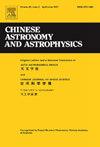逆康普顿峰频率与耀变体γ射线光子光谱指数的关系
Q4 Physics and Astronomy
引用次数: 0
摘要
以Fermi/LAT (Large Area Telescope) 4fpl - dr3 (The 4th Fermi Gamma-ray data Release 3) blazars为样本,研究了不同亚类blazars的逆康普顿峰频率(lgνpIC)与Γ射线光子光谱指数({\rm Γ})之间的关系。结果表明:在耀变体的所有亚类样本中,Γ Γ pic与Γ之间存在很强的负相关关系,表明Γ射线光子谱指数对耀变体的逆康普顿谱具有很强的主导作用,利用它们之间的关系可以快速估算出逆康普顿峰频率。不同亚类耀变体逆康普顿发射的光谱能量分布(SEDs)可能具有不同的光谱结构函数。因此,对于不同的样本,应该使用不同的函数来拟合它们的SEDs。本文章由计算机程序翻译,如有差异,请以英文原文为准。
The Relationship between the Inverse Compton Peak Frequency and the γ-ray Photon Spectral Index for Blazars
The relationship between the inverse Compton peak frequency () and -ray photon spectral index ({\rm }) for different subclasses of blazars was studied using Fermi/LAT (Large Area Telescope) 4FGL-DR3 (The 4th Fermi Gamma-ray LAT-Data Release 3) blazars as a sample. The results show that: there is a strong negative correlation between and for all subclass samples of blazars, indicating that the -ray photon spectral index has a strong dominant effect on the inverse Compton spectrum of blazars, and the inverse Compton peak frequency can be quickly estimated using the relationship between them. The spectrum energy distributions (SEDs) of the inverse Compton emission for different subclass sample of blazars may have different spectral structure functions. Therefore, for different samples, different functions should be used to fit their SEDs.
求助全文
通过发布文献求助,成功后即可免费获取论文全文。
去求助
来源期刊

Chinese Astronomy and Astrophysics
Physics and Astronomy-Astronomy and Astrophysics
CiteScore
0.70
自引率
0.00%
发文量
20
期刊介绍:
The vigorous growth of astronomical and astrophysical science in China led to an increase in papers on astrophysics which Acta Astronomica Sinica could no longer absorb. Translations of papers from two new journals the Chinese Journal of Space Science and Acta Astrophysica Sinica are added to the translation of Acta Astronomica Sinica to form the new journal Chinese Astronomy and Astrophysics. Chinese Astronomy and Astrophysics brings English translations of notable articles to astronomers and astrophysicists outside China.
 求助内容:
求助内容: 应助结果提醒方式:
应助结果提醒方式:


